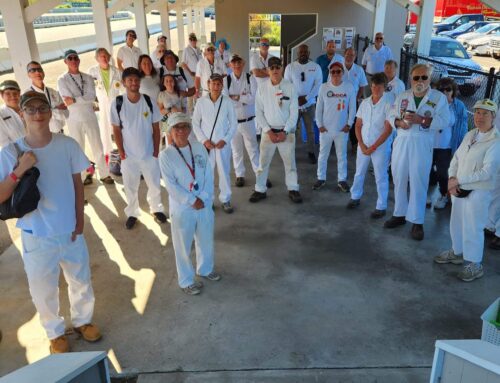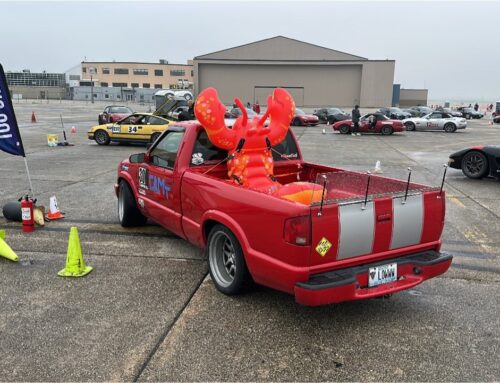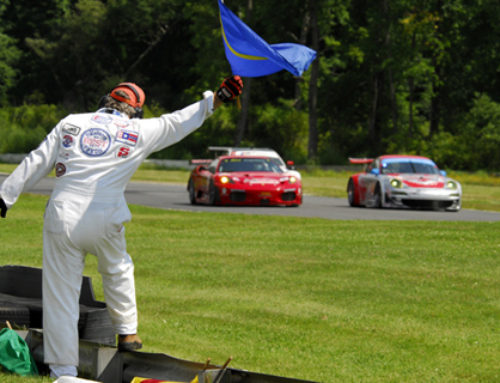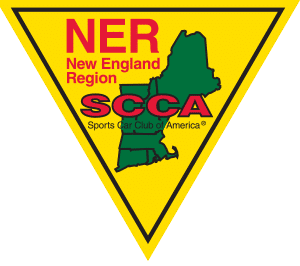Photos and Text by James Ray

It’s been said, “What’s old, is new again!” Welcome to Spec E30, newest old car racing class in New England Region SCCA. Look for SE30 identification letters on an old BMW 3 series race car – and that’s one of them!
Spec E30 racing is described as a competitive, fun, safe, affordable racing class. Rules and regulations were drafted in 2021, with the intention of creating another spec-level playing field where the racers can compete almost solely based on their driving skills. Deep wallets, performance engine builds, and trick parts made from unobtanium will not be the significant determining factor in an SE30 race car’s performance or the driver’s ability to go fast.
The underlying spec race car is BMW’s second generation 3 Series known as the E30 model. Eligible cars were built between 1982 and 1994. Various model designations were 318i, 318is, 325, 325 Convertible, 325E, 325i, or 325is. The 325is model, equipped with a M20b25 six-cylinder engine, 5 speed Getrag manual transmission, and 3.73 limited slip differential, is the easy button for racing in the SE30 class, but any E30 chassis can be converted to the spec.
The motor must remain stock except for specified updates to the air flow meter, rocker arms, and an optional skid plate helpful in protecting the oil pan. The original BMW engine manifold must be retained and there is a single-supplier approved muffler. The spec engines were produced between 1977 to 1993 and installed in both 3 series and 5 series BMW’s. Used engines are more plentiful as spares than are the E30 chassis.
SE30 provides uniquely tight racing at what in racing terms is an awesome budget.

#52 Larry Marks & #2 Nat Wentworth navigating turn 1 at Palmer
SpecE30 showed up first almost twenty years ago with another club, National Auto Sport Association (NASA). The Northeast region of NASA runs only one event at Lime Rock Park and all their other events are further away from New England.
Several SE30 race drivers living in New England wondered if there might be a better alternative to driving long distances to race with NASA at New Jersey Motorsports Park Lightning and Thunder, Pocono Raceway, Watkins Glen International, and Pittsburg International. Massachusetts residents Tom Samuelson and Jeff Hutton attended a New England Region board meeting as guests to inquire if the SE30 class could be established allowing them to race at SCCA events. Tom says, “We were very unsure what the reaction or response might be.” What they discovered was a receptive leadership group anxious to welcome a new racing class with a group of active racers.
Having received board approval in concept, several SE30 racers worked with Dick Patullo to compile the rules document, got the class established as a region only class, and SE30 racing in New England Region started pretty soon after the ink was dry.
I interviewed several SE30 racers including Tom Samuelson, Jeff Hutton, Scott Smith, Larry Marks, and newcomer Elizabeth Jolly in preparation for writing this article.
I quickly learned SCCA honors many other organizations competition licenses for regional races including NASA, BMW, PCA and many others as long as the drivers is either a weekend or full SCCA member. For those license holders who would like a SCCA license it is usually as simple as contacting their SCCA Divisional Licensing Administrator.
I asked every driver several basic questions and their response when asked “what’s the appeal to racing in the SE30 class?” were all quite similar. Tom Samuelson mentioned two interchangeable benefits, saying, “SE30 provides uniquely tight racing at what in racing terms is an awesome budget.”
Jeff Hutton made a similar comment saying, “SE30 is fun AND affordable, my brake pads and tires last longer than a season!”
Larry Marks reiterated his own comments about affordability and fun, and explained further, “I haven’t needed professional mechanics because the BMW E30’s are very simple cars.” Larry learned to do his own maintenance and says he is “comfortable preparing and maintaining the car myself, plus the SE30 community of drivers is so great!”
The SE30 community aspect came up more than once in my conversations with the various drivers. I heard stories of how they all help each other with spare parts at the track, sometimes working as a group to help change an engine or transmission whether it’s at the track or someone’s home garage. When I asked follow-up questions about the comradery, Tom Samuelson says whenever they talk it doesn’t take long before the subject of food comes up. Apparently the menu is related to the venue: Lime Rock is lobsters, NHMS is steak, Palmer is usually salmon, and TSMP is hot dogs and burgers. They all paddock near one another, share cooking out, and eat together at the track.

#5 Ed Werry (HP from SJR) and #84 Dave McGrath
As a newcomer, Elizabeth was quick to point out how helpful it has been that SE30 has an active text chat and email network. The group communicates regularly helping one another. The SE30 bug is contagious and Elizabeth has already “infected” one of her autocross friends, Audra Teller, who she hooked on the E30 by inviting Audra to Track Night in America. It wasn’t long before the SE30 community collaborated in helping Audra find an E30 race car for sale, haul it up to New England from New Jersey, and store it temporarily until Audra had parking space for it.
A growing concern several drivers mentioned is E30 chassis costs. Prices for old BMW E30’s have bottomed out and are trending up, regardless of condition. Knowing BMW sold 2.3 million of the E30’s worldwide, 1.9 million with manual transmissions, and 1.1 million with the M20 engine, one might think the cars would be plentiful. In reality, barely 400 thousand E30’s were sold in North America and that’s much less than the original Mazda Miata NA/NB models.

#22 Elizabeth Jolly participating in CRE at Palmer Motorsports Park

Example of junkyard BMW M20b25 engine
SE30 racers regret too many may have ended up in accidents and prematurely sent to the junk yard crusher, or developed rust problems after four decades of being driven in humid or snowy climates. Because the E30 is so much fun to drive and still popular, many of the better examples are being restored or preserved by vintage car collectors. Racers also suspect the less collectible remaining chassis are popular as rear wheel drive drift cars tricked out by younger millennials and Gen-Z’ers who stuff bigger motors into the engine bay. Ultimately it means old E30’s for sale have become scarce and scarcity drives up prices.
Fortunately, SE30’s are easy on consumables and repair parts like brake rotors and calipers, which are commodity priced products at many auto-parts chain stores. More significant repair and spare parts – like engines, manual transmissions, limited slip differentials – are often available on Craigslist, eBay and Facebook marketplace, and seem reasonably priced. All this is good for controlling operating costs, but rust-free donor car chassis’ suitable for building a race car are getting more difficult to find. Market prices for purchasing an E30 are rising and reflect the increasing scarcity.
I asked each of the drivers about their racing experience. Two of them raced with NASA before and others began wheel-to-wheel racing in an endurance series before club racing with the New England Region. A couple competed in other class cars and some started racing in SE30. Most have driven all of New England Region’s regularly scheduled tracks and many have driven tracks outside the region.
Optimally built to weight 2,700# and producing 160 hp, an SE30 is capable of top speeds well over 100mph, yet all agree the old BMW E30’s meet every criterion for a momentum race car! Racer Larry Marks jokingly describes his SE30 race car as “a brick on wheels,” and explains competing in a momentum car like the SE30 has made him become better driver. Whenever Tom Samuelson talks about the benefits of the SE30 class he also says “the SE30 is a skill building race car.”
Jeff Hutton is a long-term BMW aficionado. He remembers buying his E30 eighteen years ago for $600 and spent many years developing it as a dedicated autocross car. Four years ago, Jeff invested $3,500 installing a six-point roll cage and even more money downgrading his autocross car to meet the spec requirements for racing in SE30. Jeff enjoys racing in the SE30 class saying “the drivers in our group are great guys, really good on track, especially Scott who really challenges me. Everyone is respectful on track and then afterwards we help each other, hang out in the paddock and have food.”
Everyone is respectful on track and then afterwards we help each other, hang out in the paddock and have food.

#3 Jeff Hutton at Thompson Speedway Motorsports Park Midnight Madness event

For many years Elizabeth Jolly auto crossed and tracked her Porsche 944. She also co-drove a friend’s road racing prepped Boxster, but never felt like she fit well. Elizabeth exuberantly says “the minute I sat in my E30, I felt one with the car!” Elizabeth remembers her 2022 season was an eye opener. That was when she finally felt more confident in her car and exuberantly stated “I can do this, the SE30 is such a great car and I love driving it.” Elizabeth is one of the newest SE30 racers. She did her first Club Racing Experience (CRE) pre-pandemic in a Porsche 944 and came back to CRE again last season driving her “new” SE30 race car.
The 2022 Regional Champion in SE30 class was Scott Smith. He has the most racing experience in the group. After getting back into motorsports a decade ago, initially Scott raced his E30 in NASA’s GTS1 class. It was the slowest of the German Touring Series and therefore not that popular. He found too few competitors racing in the class so he converted his car to run in SE30. Often there we a dozen or more drivers entering races. Now that he’s started racing with SCCA, Scott is encouraging his NASA buddies to join NERSCCA at Lime Rock Park, which is the closest track for many of the NASA Northeast racers living south of New York City. Scott says “NASA doesn’t have a night race so the Midnight Madness event at Thompson Speedway also has a lot of appeal.” All the SE30 drivers want to attract more people to the class and raise the average SE30 car counts participating in New England Region race events.
The region’s newest old car class SE30 has lots to offer for racers. Once your SE30 race car is built or purchased, the class provides close racing, affordable operating costs, and a great community of fellow drivers willing to race hard and fair on track and help each other back in the paddock. And if you’re lucky with your car there is a good chance your race car’s value will appreciate while being raced!







